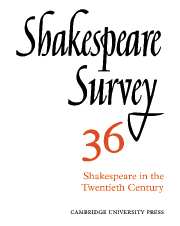Book contents
- Frontmatter
- Shakespeare and the Living Dramatist
- Blood and Wine: Tragic Ritual from Aeschylus to Soyinka
- Hamlet Andante/Hamlet Allegro: Tom Stoppard’s Two Versions
- Auden, Shakespeare, and the Defence of Poetry
- Graves on Lovers, and Shakespeare at a Lovers’ Funeral
- Tragic Balance in Hamlet
- Hamlet Across Space and Time
- Shakespeare’s Scripts and the Modern Director
- ‘He Shall Live a Man Forbid’: Ingmar Bergman’s Macbeth
- Komisarjevsky at Stratford-upon-Avon
- Troilus and Cressida and the Definition of Beauty
- The Pastoral Reckoning in Cymbeline
- New Created Creatures: Ralph Crane and the Stage Directions in The Tempest
- Arden of Faversham
- ‘Pickleherring’ and English Actors in Germany
- Shakespeare Performances in Stratford-upon-Avon and London, 1981–2
- The Year's Contributions to Shakespearian Study 1 Critical Studies
- 2 Shakespeare’s Life, Times and Stage
- 3 Textual Studies
- Index
- Plate Section
Tragic Balance in Hamlet
Published online by Cambridge University Press: 28 March 2007
- Frontmatter
- Shakespeare and the Living Dramatist
- Blood and Wine: Tragic Ritual from Aeschylus to Soyinka
- Hamlet Andante/Hamlet Allegro: Tom Stoppard’s Two Versions
- Auden, Shakespeare, and the Defence of Poetry
- Graves on Lovers, and Shakespeare at a Lovers’ Funeral
- Tragic Balance in Hamlet
- Hamlet Across Space and Time
- Shakespeare’s Scripts and the Modern Director
- ‘He Shall Live a Man Forbid’: Ingmar Bergman’s Macbeth
- Komisarjevsky at Stratford-upon-Avon
- Troilus and Cressida and the Definition of Beauty
- The Pastoral Reckoning in Cymbeline
- New Created Creatures: Ralph Crane and the Stage Directions in The Tempest
- Arden of Faversham
- ‘Pickleherring’ and English Actors in Germany
- Shakespeare Performances in Stratford-upon-Avon and London, 1981–2
- The Year's Contributions to Shakespearian Study 1 Critical Studies
- 2 Shakespeare’s Life, Times and Stage
- 3 Textual Studies
- Index
- Plate Section
Summary
The breakdown in sympathy for Hamlet – the prince, that is – during the twentieth century seems to me a critical and cultural fact of some importance, and I believe it has inhibited a genuinely tragic response to the play. Yet although the criticism of our time has eroded the tragic quality of Hamlet, one can see latent within that criticism the possibilities of a renewal which might bring the play back to us as tragedy. The twentieth-century view of the play developed as an antithesis to the view which prevailed in the nineteenth century. The new view that one envisages emerges as a synthesis of the two earlier views. I shall argue that this emerging view, though necessarily a product of our own times, could restore to Hamlet something of the tragic quality that may have belonged to the play in its own day.
The nineteenth-century view, the thesis with which we begin, received its latest and greatest expression in Bradley's Shakespearean Tragedy in 1904. It is a vision of a noble and generous youth who for reasons quite mysterious to himself is unable to carry out the sacred duty, imposed by divine authority, of punishing an evil man by death. It is a vision of paralysis and disablement, of ultimate victory bought at a terrible cost.
- Type
- Chapter
- Information
- Shakespeare Survey , pp. 43 - 52Publisher: Cambridge University PressPrint publication year: 1983
- 4
- Cited by



